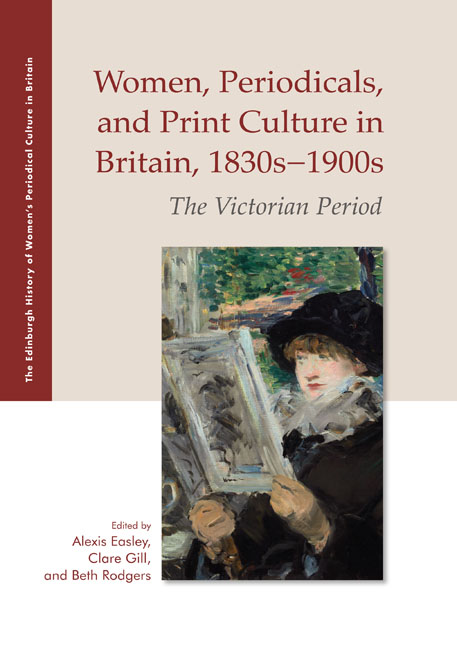Book contents
- Frontmatter
- Contents
- List of Illustrations
- Acknowledgments
- Introduction: Women, Periodicals, and Print Culture in the Victorian Period
- Part I (Re)Imagining Domestic Life
- Part II Constructing Modern Girls and Young Women
- Part III Women and Visual Culture
- Women and Visual Culture: Introduction
- 13 Vicarious Pleasures: Photography, Modernity, and Mid-Victorian Domestic Journalism
- 14 Beauty Advertising and Advice in the Queen and Woman
- 15 Women of the World: The Lady's Pictorial and Its Sister Papers
- 16 Rewriting Fairyland: Isabella Bird and the Spectacle of Nineteenth-Century Japan
- 17 Victorian Women Wood Engravers: The Case of Clemence Housman
- Part IV Making Space for Women
- Part V Constructing Women Readers and Writers
- Part VI Intervening in Political Debates
- Notes on Contributors
- Index
- Plate section
16 - Rewriting Fairyland: Isabella Bird and the Spectacle of Nineteenth-Century Japan
from Part III - Women and Visual Culture
Published online by Cambridge University Press: 25 October 2019
- Frontmatter
- Contents
- List of Illustrations
- Acknowledgments
- Introduction: Women, Periodicals, and Print Culture in the Victorian Period
- Part I (Re)Imagining Domestic Life
- Part II Constructing Modern Girls and Young Women
- Part III Women and Visual Culture
- Women and Visual Culture: Introduction
- 13 Vicarious Pleasures: Photography, Modernity, and Mid-Victorian Domestic Journalism
- 14 Beauty Advertising and Advice in the Queen and Woman
- 15 Women of the World: The Lady's Pictorial and Its Sister Papers
- 16 Rewriting Fairyland: Isabella Bird and the Spectacle of Nineteenth-Century Japan
- 17 Victorian Women Wood Engravers: The Case of Clemence Housman
- Part IV Making Space for Women
- Part V Constructing Women Readers and Writers
- Part VI Intervening in Political Debates
- Notes on Contributors
- Index
- Plate section
Summary
It is a doll's street with small low houses, so finely matted, so exquisitely clean, so finically neat, so light and delicate, that even when I entered them without my boots I felt like a ‘bull in a china shop,’ as if my mere weight must smash through and destroy. The street is so painfully clean that I should no more think of walking over it in muddy boots than over a drawing-room carpet. (Bird 1880: 1.101)
ISABELLA BIRD, INTREPID VICTORIAN, was travel-weary and spattered with grime from trekking over the mountains when she arrived in Hachiishi on horseback in 1879. Emerging from the avenue of cryptomeria trees – long-lived Japanese cedars that can grow over 200 feet high – she proceeded into a town so small, delicate, and clean that it felt almost imaginary. Very much like a human interloper in fairyland, a trope that would have been deeply familiar to her contemporaries, Bird describes herself as being not just out of place but outsized on this ‘doll's street.’ This passage is one of many in which Bird figures Japan as an ethereal realm inhabited by diminutive creatures amongst whom she feels as dirty, awkward, blundering, and large as any child who has been whisked to the fairy realm to be cured of her faults. At only four feet eleven inches tall, even in bulky Western woollens, Bird was hardly as outsized as this passage suggests. So why does fairyland serve as such a central metaphor in Bird's Unbeaten Tracks in Japan?
The answer to that question has to do in part with the sense of delightful mystery that Japan evoked during the second half of the nineteenth century. Japan had closed its borders in the late 1630s in an effort to prevent foreign interests in trade and religion from shaping Japanese life. Japanese citizens were not allowed to travel abroad, and foreigners were not allowed to enter; external commerce was limited to partnerships with specially chartered Chinese and Dutch ships. The ports remained effectively closed to the world until Commodore Matthew Perry arrived with warships, presented President Fillmore's treaty demands, and ultimately negotiated the Treaty of Kanagawa, signed in March 1854.
- Type
- Chapter
- Information
- Women, Periodicals and Print Culture in Britain, 1830s–1900sThe Victorian Period, pp. 256 - 276Publisher: Edinburgh University PressPrint publication year: 2019

